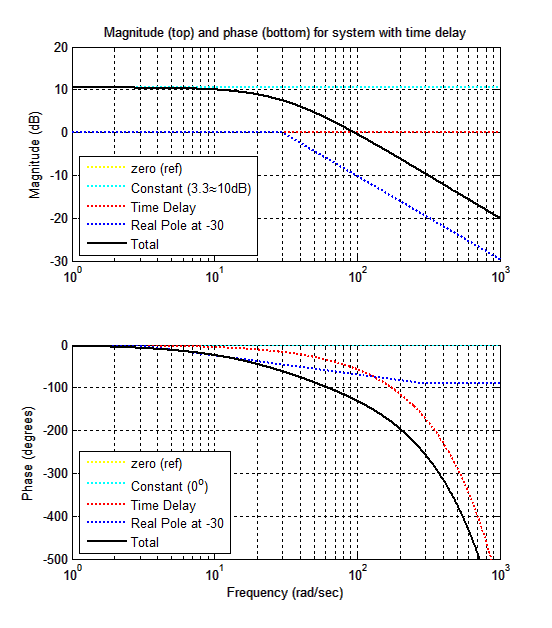Bode Plot: Example 7
Draw the Bode Diagram for the transfer
function:

This is the same as "Example 1," but has a 0.01
second time delay. We have not seen a time delay before this, but we can
easily handle it as we would any other constituent part of the transfer
function. The magnitude and phase of a time delay are described
here.
Step 1: Rewrite the
transfer function in proper form.
Make both the lowest order term in the numerator and
denominator unity. The numerator is an order 0 polynomial, the
denominator is order 1.

Step 2: Separate the
transfer function into its constituent parts.
The transfer function has 3 components:
- A constant of 3.3
- A pole at s=-30
- A time delay of 0.01 seconds (magnitude and phase of time delay described
here).
Step 3: Draw the Bode
diagram for each part.
This is done in the diagram below.
- The constant is the cyan line (A
quantity of 3.3 is equal to 10.4 dB). The phase is constant at 0
degrees.
- The pole at 30 rad/sec is the blue
line. It is 0 dB up to the break frequency, then drops off with a
slope of -20
dB/dec. The phase is 0 degrees up to 1/10 the break frequency (3 rad/sec)
then drops linearly down to -90 degrees at 10 times the break frequency
(300 rad/sec).
- The time delay is the red line. It is 0 dB at all frequencies.
The phase of the time delayis given by -0.01·ω rad, or
-0.01·ω·180/π° (at ω=100 rad/sec, the
phase is -0.01·100·180/π≈-30°). There
is no asymptotic approximation for the phase of a time delay. Though
the equation for the phase is linear with frequency, it looks exponential
on the graph because the horizontal axis is logarithmic.
Step 4: Draw the overall Bode diagram by
adding up the results from step 3.
The exact response is the black line.




